Comments / Questions (18)
![]() Sissi wrote:
Sissi wrote:
Gibt es hier keine verkürzten Reihen für den Nackenbereich. Ein Pullover sitzt doch am Körper viel angenehmer, besser mit verkürzten Reihen, oder (erhöhtem Nacken) etwa nicht? Wie könnte ich bei diesem Modell für eine bessere Passform rechnen? Liebe Grüße und vielen Dank. 🕊💫🕊
10.01.2024 - 15:00DROPS Design answered:
Liebe Sissi, eine Erhöhung können Sie dann nach einem ähnlichen Modell (selbe Maschenprobe) stricken. Viel Spaß beim stricken!
10.01.2024 - 16:21
![]() José wrote:
José wrote:
Ik begrijp niet hoe je de boord breit met 1 st recht gedraaid en dan 1 averecht. Wat is gedraaid?
26.10.2023 - 08:58DROPS Design answered:
Dag José,
Bij de lijst met video's onderaan het patroon staat ook een video over hoe je gedraaid recht breit. Hier is de link naar de video.
26.10.2023 - 19:55
![]() José Marx wrote:
José Marx wrote:
Ik begrijp niet hoe je de boord breit met 1 st recht gedraaid en dan 1 averecht. Wat is gedraaid?
26.10.2023 - 08:56
![]() Müller Lu wrote:
Müller Lu wrote:
Ich möchte diesen Pulli mit einer dünnen Alpaka Seide Wolle stricke. Wie kann ich diese Aneitung umrechnung in ein dünneres Garn.
12.03.2023 - 21:19DROPS Design answered:
Liebe Frau Müller, leider könnnen wir nicht jede Anleitung nach jeder Maschenprobe/Anfrage anpassen, aber hier finden Sie alle unsere gestrickte nordische Pullover mit Maschenprobe 25-23 Maschen, sicher kann Ihnen davon inspirieren. Viel Spaß beim stricken!
13.03.2023 - 10:22
![]() Ana Alves wrote:
Ana Alves wrote:
I wish to make this pullover from bottom to top and I am using more colors, is it still possible to keep it without seams or hole marks around shoulders and breast? Would you be so kind to guide me to a design where I may learn how to do it? Thank you
03.03.2023 - 10:53DROPS Design answered:
Bom dia, É possível tricotar de baixo para cima, em redondo, mas deverá fazer os cálculos por si mesma, ou seja, inverter todos os números de malhass, de aumentos/diminuições. Pode também pesquisar na home page do nosso site por modelos em redondo, com encaixe arredondado. que se tricotem de baixo para cima e encontrará outros modelos com jacquard..:-) Bons tricôs!
03.03.2023 - 11:23
![]() Jette Larsen wrote:
Jette Larsen wrote:
Der står i opskrift, at jeg skal tage ud 5 gange på bærestykket, men der i diagram sat 6 mærker af til udtagning. Hvilket af de 2 er korrekt🤔
20.02.2023 - 07:06DROPS Design answered:
Hej Jette, det kommer an på hvilken størrelse du strikker :)
23.02.2023 - 15:09
![]() Eva wrote:
Eva wrote:
Hei, holder på å strikke denne genseren. Men når jeg strikker på Bolen under armene står det i oppskriften - strikk til arbeidet møller 28 cm før du skal øke med et antall masker(i min str. 32 masker) ER dette rett? Dette vil da si att økningen kommer langt ned. Ev (
13.02.2023 - 12:20DROPS Design answered:
Hei Eva. I denne oppskriften er det ingen økninger under ermene, men du øker masker i siste omgang før vrangborden. Dette gjøres for å få en penere overgang mellom bol og vrangbord. Så oppskriften stemmer :) mvh DROPS Design
13.02.2023 - 14:16
![]() Wendy Annette Thomassen wrote:
Wendy Annette Thomassen wrote:
Jeg har strikket den fine sweater, i drops Air. Jeg syndes at den er blevet bredere i omkreds, og derfor lidt for kort. Nu vil jeg strikke en mere i perlegrå, og må så tage lidt ind i omkredsen. Jeg kan ikke forstå hvorfor man skal tage ud, lige før ribben skal strikkes forneden. I butikken hvor jeg købte garnet, siger de at der skal blandes en tråd i, for ellers holder den ikke faconen. Er det rigtigt, og hvad tråd er det? Tak
18.09.2022 - 22:16DROPS Design answered:
Hej Wendy, nej det stemmer ikke! Blusen er strikket i 1 tråd DROPS Air. Lav en strikkeprøve, du skal have 16 masker på 10 cm for at få målene som du finder i måleskitsen nederst i opskriften. :)
20.09.2022 - 14:46
![]() Linda Bjelkeflo wrote:
Linda Bjelkeflo wrote:
Jättefin tröja! Jag skulle vilja göra den i andra färger med Drop Air Beige mix 26 som bottenfärg istället för vete, sen vill jag ha mönstret i blå färger istället för röda nyanser, vilka blå färger skulle ni rekommendera att jag byter ut brun, beige, rubinröd, röd tegelsten och gammelrosa till?
31.03.2022 - 16:34DROPS Design answered:
Hei Linda. Å gi andre fargevalg er vanskelig siden det er så personlig. Men kanskje beholde bruntonene/bytte 26 med 35. Og så bytte de 3 rødlige fargene med blålige farger. Bytt den mørkeste rød til en mørk blå, mellomste rødlig til en mellomst blålig osv. Men pass på at det er noen blåfarger DU syns passer sammen. mvh DROPS Design
04.04.2022 - 13:45
![]() Lise wrote:
Lise wrote:
This is a wonderful pattern, however note that I needed 300g of the basic color for Size M. Thank you!
05.02.2022 - 12:05
Mistletoe Kisses#mistletoekissessweater |
||||||||||||||||||||||
 |
 |
|||||||||||||||||||||
Knitted jumper in DROPS Air. The piece is worked top down with round yoke, Nordic pattern and double neck. Sizes S - XXXL.
DROPS 217-7 |
||||||||||||||||||||||
|
------------------------------------------------------- EXPLANATIONS FOR THE PATTERN: ------------------------------------------------------- PATTERN: See diagram A.1. The whole pattern is worked in stocking stitch. KNITTING TIP: To avoid the knitting tension becoming tighter when working pattern, it is important that the strands at the back are not tight. Use a size larger needle when working pattern if this is a problem. If the knitting tension is not correct in height and you work too tightly, the garment will be short and the armholes too small – you can correct for this by regularly working an extra row in the 1-coloured sections. If you work loosely, the garment will be too long and the armholes too big – you can correct for this by regularly working 1 round less in the 1-coloured sections. INCREASE TIP (evenly spaced): To work out how to increase evenly, count the total number of stitches on the needle (e.g. 80 stitches) and divide by the number of increases to be made (e.g. 22) = 3.6. In this example, increase by making 1 yarn over after alternately each 3rd and 4th stitch. On the next round knit the yarn overs twisted to avoid holes. DECREASE TIP (for sleeves): Decrease 1 stitch on either side of the marker thread as follows: Work until there are 3 stitches left before the marker thread, knit 2 together, knit 2 (marker thread sits between these 2 stitches), slip 1 stitch as if to knit, knit 1 and pass the slipped stitch over the knitted stitch. CASTING-OFF TIP: To avoid the cast-off edge being tight you can cast off with a larger size needle. If the edge is still tight, make 1 yarn over after approx. each 4th stitch at the same time as casting off; the yarn overs are cast off as normal stitches. ------------------------------------------------------- START THE PIECE HERE: ------------------------------------------------------- JUMPER – SHORT OVERVIEW OF THE PIECE: The neck and yoke are worked in the round with circular needle, top down from the transition between left sleeve and the back piece. The yoke is divided for body and sleeves and the body continued in the round with circular needle. The sleeves are worked in the round with short circular needle/double pointed needles, top down. DOUBLE NECK: Cast on 80-84-88-94-96-102 stitches with circular needle size 4.5 mm and wheat. Knit 1 round, then work rib (= knit 1 twisted, purl 1) in the round for 9 cm. When the rib is finished, knit 1 round where you increase 22-24-26-26-30-36 stitches evenly spaced – read INCREASE TIP = 102-108-114-120-126-138 stitches. Change to circular needle size 5.5 mm and insert 1 marker at the beginning of the round; the yoke is measured from this marker! YOKE: Work A.1 (= 6 stitches) a total of 17-18-19-20-21-23 times on the round – remember KNITTING TIP. On the rounds with stars increase as follows – remember INCREASE TIP: Star-1: Increase 24-30-30-30-30-36 stitches evenly spaced = 126-138-144-150-156-174 stitches. Star-2: Increase 30-30-30-30-30-30 stitches evenly spaced = 156-168-174-180-186-204 stitches. Star-3: Increase 30-30-30-30-30-30 stitches evenly spaced = 186-198-204-210-216-234 stitches. Star-4: Increase 30-36-30-30-30-30 stitches evenly spaced = 216-234-234-240-246-264 stitches. Star-5: Increase 24-30-30-30-30-36 stitches evenly spaced = 240-264-264-270-276-300 stitches. Sizes S and M are now finished with increases. Go to All sizes below. Sizes L, XL, XXL and XXXL continue to: Star-6: Increase 24-18-36-36 stitches evenly spaced = 288-288-312-336 stitches. All sizes: Continue with pattern until the piece measures 22-24-25-26-28-30 cm from the marker on the neck. Continue the pattern on the next round as follows: Work the first 72-78-84-84-96-102 stitches (= back piece), place the next 48-54-60-60-60-66 stitches on a thread for the sleeve and cast on 6-6-6-12-12-12 new stitches (in side under the sleeve), work the next 72-78-84-84-96-102 stitches (= front piece), place the next 48-54-60-60-60-66 stitches on a thread for the sleeve and cast on 6-6-6-12-12-12 new stitches (in side under the sleeve). Body and sleeves are finished separately. THE PIECE IS NOW MEASURED FROM HERE! BODY: = 156-168-180-192-216-228 stitches. Continue in the round until A.1 has been completed then continue with wheat to finished length. When the piece measures 26-26-27-28-28-28 cm from the division, knit 1 round where you increase 28-30-32-32-36-38 stitches evenly spaced = 184-198-212-224-252-266 stitches. Change to circular needle size 4.5 mm and work rib (= knit 1 twisted, purl 1) for 4 cm. Cast off with knit over knit and purl over purl - read CASTING-OFF TIP. The jumper measures approx. 56-58-60-62-64-66 cm from the shoulder down. SLEEVE: Place the 48-54-60-60-60-66 stitches from the thread on the one side of the piece on short circular needle/double pointed needles size 5.5 mm and knit up 1 stitch in each of the 6-6-6-12-12-12stitches cast on under the sleeve = 54-60-66-72-72-78 stitches. Insert a marker thread in the middle of the 6-6-6-12-12-12 stitches under the sleeve (3-3-3-6-6-6 stitches on each side of the thread). Continue in the round with pattern in the same way as on the body – the pattern will not fit under the sleeve. When the sleeve measures 5-3-3-3-3-3 cm from the division, decrease 1 stitch on each side of the marker thread - read DECREASE TIP. Decrease like this every 3½-3-2½-2-2-1½ cm a total of 9-11-13-15-14-17 times = 36-38-40-42-44-44 stitches. Continue working until the sleeve measures 37-36-35-34-33-31 cm (shorter measurements in larger sizes due to longer yoke), knit 1 round where you increase 6-6-6-6-8-8 stitches evenly spaced = 42-44-46-48-52-52 stitches. Change to double pointed needles size 4.5 mm and work rib (= knit 1 twisted, purl 1) for 5 cm. Cast off with knit over knit and purl over purl – remember CASTING-OFF TIP. Work the other sleeve in the same way. ASSEMBLY: Fold the top of the neck to the wrong side and fasten down. To avoid the neck being tight and rolling outwards, it is important that the seam is elastic. |
||||||||||||||||||||||
Diagram explanations |
||||||||||||||||||||||
|
||||||||||||||||||||||

|
||||||||||||||||||||||
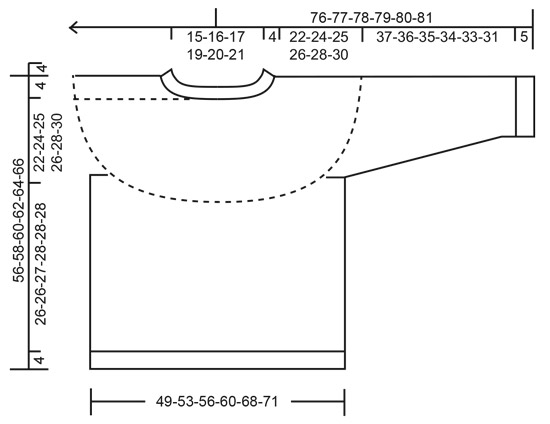
|
||||||||||||||||||||||
Have you finished this pattern?Tag your pictures with #dropspattern #mistletoekissessweater or submit them to the #dropsfan gallery. Do you need help with this pattern?You'll find 29 tutorial videos, a Comments/Questions area and more by visiting the pattern on garnstudio.com. © 1982-2025 DROPS Design A/S. We reserve all rights. This document, including all its sub-sections, has copyrights. Read more about what you can do with our patterns at the bottom of each pattern on our site. |
||||||||||||||||||||||







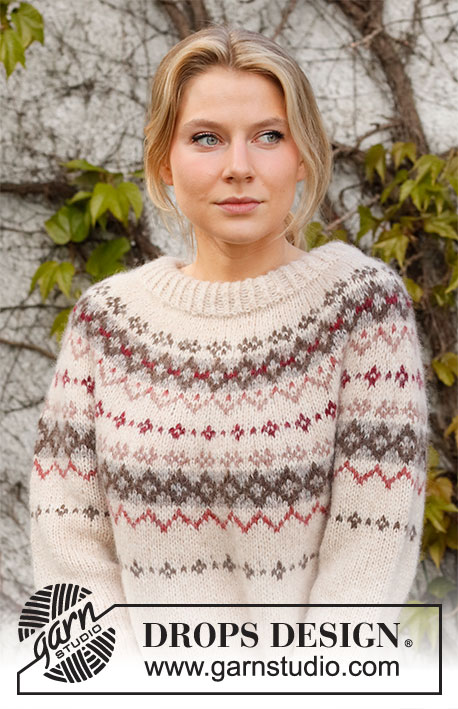
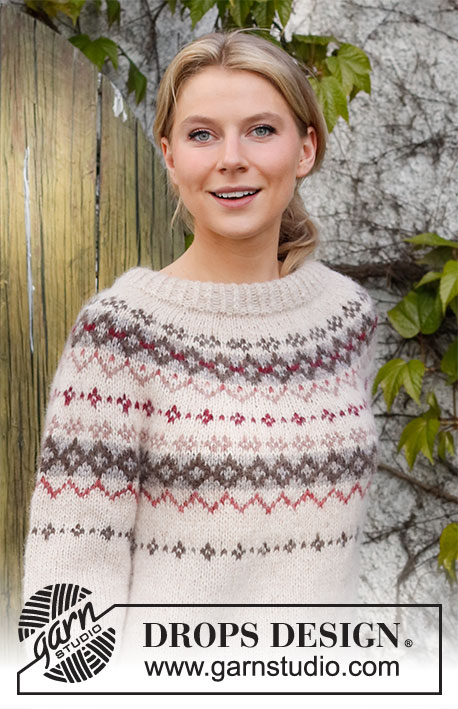
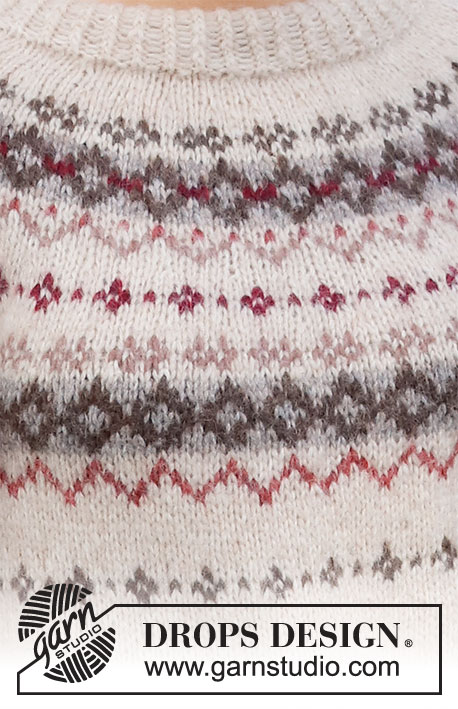


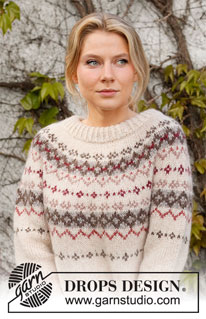
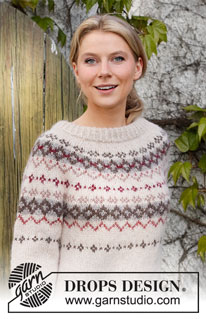

































































Post a comment to pattern DROPS 217-7
We would love to hear what you have to say about this pattern!
If you want to leave a question, please make sure you select the correct category in the form below, to speed up the answering process. Required fields are marked *.